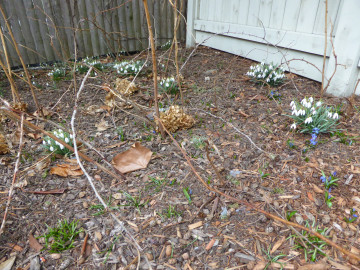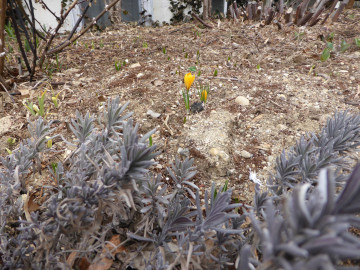Leonard Moorehead, The Urban Gardener: April Opens with Kindness
Saturday, April 01, 2017
My friends dwell in pockets of sunshine. Long before leaves emerge from trees and shrubs sunshine pours into those nooks and crannies so delightful to find. During lunch time walks and those purposeful routes to the bus stop we stop to greet one another. Anyone who has lived or worked in a neighborhood finds the spots. My home is in an old city at just about ground zero for introduction of European plants. They, just as their native predecessors, have adapted around us. Construction, hurricanes, major throughways and congested industrial pasts abut hillsides, rivers, salt water, and neighborhoods time has forgotten. Our crocus, snowdrops, grape hyacinths, witch hazel, pussy willows, and intent robins pirouette into the present. Our gardens are compassionate. Pockets of sunshine are where spring finds us first.
Share effort
Urban gardeners share their efforts. Legacy plantings prevail to display the fascinating arc of constant transition. Immense American hardwoods such as chestnut and elm are little more than street names today. Once their huge trunks and graceful limbs arched over streets and homes. Many cities and towns support tree planting. Does your sidewalk have a stump or vacant gap in paving suitable for a tree? Does relentless July sun confine you to humming air conditioners? Are you conscious of the city’s heartbeat rumble? Trees, returned to lost ground are peaceful alternatives. Contact your local forester. Talk to your neighbors. Form or join a team of like- minded folk. Gather basic shovels, I prefer the long handled variety out of respect for the lumbar, and help plant trees into open spaces. Often compost is donated by municipalities and sometimes a crew to loosen impacted soil. Lean in, breath deep, that bundled up sapling is alive, be present for birth, membership in our dynamic cities.
GET THE LATEST BREAKING NEWS HERE -- SIGN UP FOR GOLOCAL FREE DAILY EBLASTMake new friends
Make new friends, breath plenty of fresh air and help settle in a new linden, sycamore, gingko, or a disease resistant elm. Teams of neighbors need only look over their shoulders and witness the foresight of those before us. Engage now, contact your city forester, and acquire life- long reward. Thank you to those who planted lindens on sidewalks. Their heavenly scent, magnetism for bees and great size impervious to pollution or NE gales alike, demonstrate good acts are infinite benefits. Robust growth and high dense shade keep urban gardeners on their toes, sunny or shade plants? Or how about the generous harvests? Dried linden blooms are herbal tea staples, the foliage turns cheerful yellow each autumn and falls almost directly on your compost. Next year, more. Each year less CO2, less noise, shade and mute strength. Surely this is friendship’s gentle timbre. Beeches offer enchanting bark, long lives, and rain down a Fermat’s equation of geometric extremity, the artistry of nature’s Euclid. Squirrels and lovers favor beeches, hearts sometimes find their unique ways onto the bark; every crude arrow pierces hearts far past sweet 16.
Period homes
Period homes and desolate rubble punctuate our long presence. Intrepid gardeners have always existed. Urban gardeners flower pots, fire escape containers, side walk patches, and community gardens have deep cultural roots and express our better attributes. The dour Pilgrims brought cuttings of pink cabbage roses and testify to our innate love of the humble joys of nurture, care and hope. Jacobean colonists spoke the language of English gardens, virtually all plants had utilitarian merit, the subtle joys of life translated into a lexicon that pre-dates industry and technology. The Pilgrims and those of the Great Migration of the 1640s had a vision of the city on the hill, utopia. Sir Thomas More’s idealism inspired migration to a fresh, clean New World. Once in utopia colonists lived or died until their homelands gardens sent staff and grain. A huge array of herbs, grains, legumes and importantly, grass seeds made the sail from London and The Netherlands. One, our pale pink cabbage rose, its sprawling habit suggesting ways to propagate, continues to delight and are often found triumphant over fallen arbors. Like stone walls, this colonist remains. Cane roses are easy to propagate.
I layer, you can too
I layer mine, a small trench in the topsoil will suit a rose cane just fine. Start where a cane naturally bends to touch ground, usually 3 or 4 feet from the main stems, lay a brick or heavy stone to hold the cane down in the trench. We guide in the direction of growth, don’t bend canes around corners, rather extend. Dust with rootone or not, scratch a bit of bark off about every foot to make future cutting, weight, cover with compost and mulch and they’ll root for you. Cut apart when enough leaves and new canes show up and plant in a sunny place. Or if you prefer, since this rose does not hesitate, save the canes cut back in the late fall or cut pencil thick canes 6-10 inches long and plant in 10” deep plastic pots too ugly for display but perfect to bury up to their rims in garden soil. I tuck these pots into a corner where they’ll remain undisturbed but watered and watched over. Most pots will accommodate 6 to 10 cuttings, try to plant the older sections that were closest to the main plant and reveal the growing tip to sunlight. Within a growing season robust plants are ready to share with others. Gardener to gardener Shakespear’s eglantine has left Oberon’s magical bower and traveled across North America. Puck is still with us.
Propagate!
Propagate common fruit trees, roses, scrubs and vines such as grapes and goji berries. Their propagation are fun garden projects to share with youngsters. It’s very rewarding to form another generation in the making. Shouldn’t everyone plant a tree in their life? Why not a pear, apricot or peach? It is in the spirit of our times to preserve the best of our past and the future is before us. Nothing celebrates relationships as planting with a friend or companion. I garden for fragrance. When my beloved daughter came to visit I knew just the thing. As if yesterday we dug into a very sandy, gravelly spot scorched by sunshine all day. Many urban gardeners start with virtual pavement and some sovereign plants not only thrive but insist upon these harsh conditions. The champion is one brought centuries ago to stuff mattresses and make soap, lavender.
No garden
No garden is complete without lavendula agustifolia and love. Together, we set out the small lavender plants. Don’t economize on this. Do plant in prime numbers for best effect. Snow has melted away and revealed what the heart can only hope. Thrifty gray leaves on the lavender suggest success and yet I know within they are happy and healthy, the two qualities all parents pray for their children. The snow is a mere whisper away and time stands still. She is with me whenever I brush the foliage. Fragrance fills the air and swells the heart. No one is immune to this essential goodness, friend, family or foe. Love is much like gravity, mysterious and undeniable.
Sunshine has melted
Sunshine has melted away most of our snow. Lunch walkers find optimism around every corner confirmed by signal signs of spring. Witch hazel has opened on utterly undistinguished small trees. Witch hazel’s medicinal value was given to the English by the Narragansetts, it’s fragrant golden blooms are modest at first glance. They thrive in well watered soils, are easy to propagate by cuttings, and once supported a colonial medicinal cottage industry. Each bloom bares examination, the ray of golden petals surround a crimson stamen dusted in pollen. Somehow they have endured between old buildings, their lineages forgotten, their distinctive notched leaves in the future.
It pays
It pays for gardeners to see where generations of spring bulbs have established themselves. Crocus, squill, snowdrops, and grape hyacinths naturalize in spring’s sunny pockets. I plant them every fall. Yes, they last. However, spring bulbs are often overlooked as other blooms, especially daffodils, the crown of April, and summer’s introduction, tulips in May move into vision. Make a note, plant spring bulbs next October. Urban gardens are tight spaces. We plant successive crops in interloping cycles. I keep the spring bulbs to the margins. A perpetual regimen of mulch and sometimes cultivation disturbs the bulbs. I quickly replant the bulb and sometimes, as with tulips, divide the bulbs to give new cloves room to grow. Much the same are Asiatic lilies, they flourish when their bulbs are separated, coming into their own within a year. However, gardeners must sometimes make hard decisions. Don’t plant yourself into a corner and leave precious space over crowded with any one type of plant. It takes time to establish plants, don’t gamble but plant for several seasons before one moves more towards management than beginning.
Robins and mocking birds
Robins and mocking birds are claiming gardens. Cardinals call. My garden’s fall mulch is flattened from sun and visibly transforming into humus. I am careful not to walk on the soil as much as possible, where I must, I tread on burlap bags. Often free or very inexpensive, I lay then on the mulch and have a clean, attractive pathway cover easily removed or buried under compost or mulch. Until the soil has drained a bit, I hold off on cultivation, digging, any activity that compresses the soil’s tilth. It’s not easy to resist but more signs of spring will let me know when to directly sow, mix in compost, add limestone, ironite, perlite and the fun chores of later spring. Go outside and find the first spring blooms. Their colors and endurance lift the spirit.
Leonard Moorehead is a life-long gardener. He practices organic-bio/dynamic gardening techniques in a side lot surrounded by city neighborhoods in Providence RI. His adventures in composting, wood chips, manure, seaweed, hay and enormous amounts of leaves are minor distractions to the joy of cultivating the soil with flowers, herbs, vegetables, berries, and dwarf fruit trees.
Related Articles
- Urban Gardener: Composting For Winter
- Leonard Moorehead, The Urban Gardener: Wreaths Go Full Circle
- Leonard Moorehead the Urban Gardener: “Scent, First and Last”
- Leonard Moorehead the Urban Gardener: Gardener’s Wish List
- Leonard Moorehead the Urban Gardener: Hollies Forever Holidays
- The Urban Gardener: Hunker Down, Look Ahead
- Leonard Moorehead, The Urban Gardener: Fall Gardens Flush and Full
- The Urban Gardener: Leaves, the Gardener’s Friend
- The Urban Gardener: Cold Frames Endure
- Leonard Moorehead,The Urban Gardener: Minor Bulbs Rule
- Leonard Moorehead, The Urban Gardener: Before and After
- Leonard Moorehead, The Urban Gardener: Bless Garden Catalogs
- Leonard Moorehead, The Urban Gardener: Patience is Virtuous
- Leonard Moorehead, The Urban Gardener: Hope Springs Eternal
- Leonard Moorehead, The Urban Gardener: The Great Melt
- Leonard Moorehead, The Urban Gardener: Let’s Go Green
- Leonard Moorehead, The Urban Gardener: Vernal Equinox
- Leonard Moorehead, The Urban Gardener: All For Love
- Leonard Moorehead, The Urban Gardener: Seeds in the Snowbed
- Leonard Moorehead, The Urban Gardener: Icy Grip? Pass the Salt
- Leonard Moorehead, The Urban Gardener: Winter Blooms
- Leonard Moorehead, TheUrban Gardener: Snow is Good for Gardens
- Leonard Moorehead, the Urban Gardener: Spring’s Snowy Prelude
- Leonard Moorehead, The Urban Gardener: Spring Poised on the Equinox





